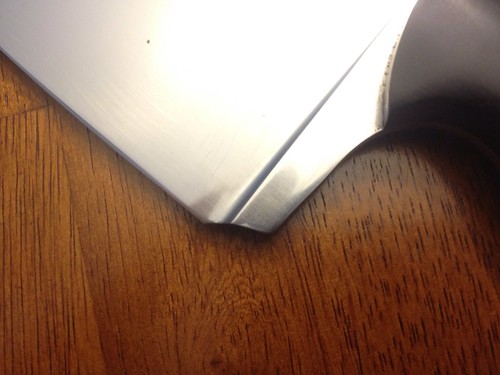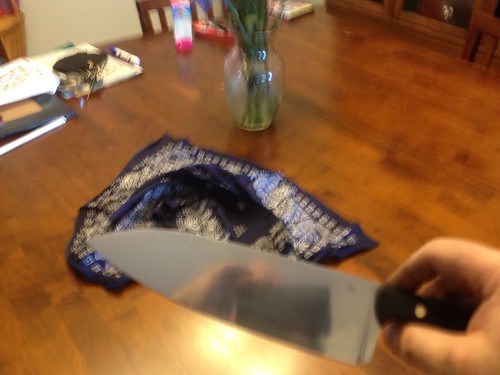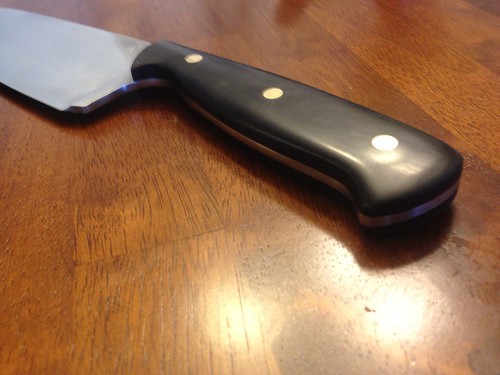Drew Riley
Well-Known Member
Just wanted to share one of my latest projects. This was one of those knives that really wasn't planned, but more of a spontaneous endeavor, after talking to a friend of mine who had bought a kitchen knife from me in the past.


Here's a pic of how I finish the "heel" of the blade, so that I ensure full edge contact with the cutting board, while still bing able to implement a ricasso into my knives.

Here's a little better view of the finish. Not quite a perfect mirror.... just a LITTLE bit of a satin polish. I hand sanded the blade up to 600 grit, then did a final fluff and buff on my buffer with some polishing rouge. Sorry for the slightly out of focus pic...

Here's a better pic of the handle. Even though a chef's knife is typically employed using a "pinch grip" just forward of the handle, I still like to have a sizeable handle that's relatively ergonomic and fills an average hand.

As for the overall specs:
8" blade
5" handle
The blade was made via stock removal from some 1/8" thick x 2.5" 1095 high carbon steel. I know that 1/8" is a little thick for a kitchen slicer, but I personally like just a little bit more heft and rigidity than the average chef's knife offers. The balance point is right at the ricasso, so it feels very good in a pinch grip and leaves just a little bit of forward weight when gripping from the handle, which I like.
I did try to do a "hamon" on this by doing a partial edge quench. I was successful, but I didn't care for how my blade etched in vinegar and lemon juice, so I polished most of it out. As it ages and patinas, the hamon will pop back out. Should be a nice little surprise for the user...
The edge is beveled at 30 degrees. This is probably a little "obtuse" for your average kitchen knife, but I feel that it's a good compromise for maintaining a sharp edge while still having a little strength behind it, since it's undoubtedly going to be bouncing off a cutting board, hitting bones, etc... Perhaps I'm overthinking/overkilling here, but those were my thoughts.
Thanks for looking guys... comments, questions, and criticism are welcome.


Here's a pic of how I finish the "heel" of the blade, so that I ensure full edge contact with the cutting board, while still bing able to implement a ricasso into my knives.

Here's a little better view of the finish. Not quite a perfect mirror.... just a LITTLE bit of a satin polish. I hand sanded the blade up to 600 grit, then did a final fluff and buff on my buffer with some polishing rouge. Sorry for the slightly out of focus pic...

Here's a better pic of the handle. Even though a chef's knife is typically employed using a "pinch grip" just forward of the handle, I still like to have a sizeable handle that's relatively ergonomic and fills an average hand.

As for the overall specs:
8" blade
5" handle
The blade was made via stock removal from some 1/8" thick x 2.5" 1095 high carbon steel. I know that 1/8" is a little thick for a kitchen slicer, but I personally like just a little bit more heft and rigidity than the average chef's knife offers. The balance point is right at the ricasso, so it feels very good in a pinch grip and leaves just a little bit of forward weight when gripping from the handle, which I like.
I did try to do a "hamon" on this by doing a partial edge quench. I was successful, but I didn't care for how my blade etched in vinegar and lemon juice, so I polished most of it out. As it ages and patinas, the hamon will pop back out. Should be a nice little surprise for the user...
The edge is beveled at 30 degrees. This is probably a little "obtuse" for your average kitchen knife, but I feel that it's a good compromise for maintaining a sharp edge while still having a little strength behind it, since it's undoubtedly going to be bouncing off a cutting board, hitting bones, etc... Perhaps I'm overthinking/overkilling here, but those were my thoughts.
Thanks for looking guys... comments, questions, and criticism are welcome.
